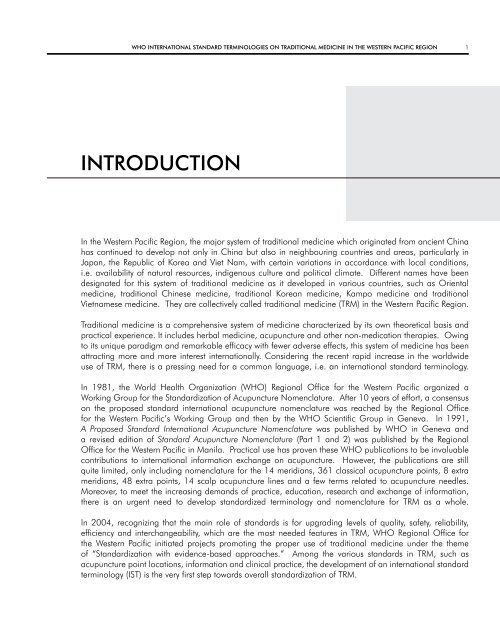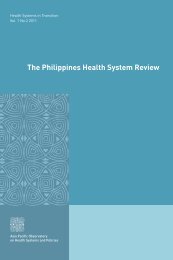- Page 3 and 4: WHO InternationalStandard Terminolo
- Page 5: TABLE OF CONTENTSFOREWORDACKNOWLEDG
- Page 12 and 13: 2IntroductionObjectives of this doc
- Page 14 and 15: 4Introduction3. Meeting on the Deve
- Page 16 and 17: 6Introduction1) Code2) Term (Englis
- Page 19 and 20: WHO INTERNATIONAL STANDARD TERMINOL
- Page 21 and 22: WHO INTERNATIONAL STANDARD TERMINOL
- Page 23 and 24: WHO INTERNATIONAL STANDARD TERMINOL
- Page 25 and 26: WHO INTERNATIONAL STANDARD TERMINOL
- Page 27 and 28: WHO INTERNATIONAL STANDARD TERMINOL
- Page 29 and 30: WHO INTERNATIONAL STANDARD TERMINOL
- Page 31 and 32: WHO INTERNATIONAL STANDARD TERMINOL
- Page 33 and 34: WHO INTERNATIONAL STANDARD TERMINOL
- Page 35 and 36: WHO INTERNATIONAL STANDARD TERMINOL
- Page 37 and 38: WHO INTERNATIONAL STANDARD TERMINOL
- Page 39 and 40: WHO INTERNATIONAL STANDARD TERMINOL
- Page 41 and 42: WHO INTERNATIONAL STANDARD TERMINOL
- Page 43 and 44: WHO INTERNATIONAL STANDARD TERMINOL
- Page 45 and 46: WHO INTERNATIONAL STANDARD TERMINOL
- Page 47 and 48: WHO INTERNATIONAL STANDARD TERMINOL
- Page 49 and 50: WHO INTERNATIONAL STANDARD TERMINOL
- Page 51 and 52: WHO INTERNATIONAL STANDARD TERMINOL
- Page 53 and 54: WHO INTERNATIONAL STANDARD TERMINOL
- Page 56 and 57: 46Basic Theories - Mechanism of Dis
- Page 58 and 59: 48Basic Theories - Mechanism of Dis
- Page 60 and 61:
50Basic Theories - Mechanism of Dis
- Page 62 and 63:
52Basic Theories - Mechanism of Dis
- Page 66 and 67:
56Basic Theories - Mechanism of Dis
- Page 68 and 69:
58Basic Theories - Mechanism of Dis
- Page 70 and 71:
60Basic Theories - Mechanism of Dis
- Page 72 and 73:
62Basic Theories - Mechanism of Dis
- Page 74 and 75:
64Basic Theories - Mechanism of Dis
- Page 76 and 77:
66Basic Theories - Mechanism of Dis
- Page 78 and 79:
68Basic Theories - Mechanism of Dis
- Page 80 and 81:
70Basic Theories - Mechanism of Dis
- Page 82 and 83:
72Basic Theories - Mechanism of Dis
- Page 84 and 85:
74Basic Theories - Mechanism of Dis
- Page 86 and 87:
76Basic Theories - OthersCode Term
- Page 88 and 89:
78DiagnosticsCode Term Chinese Defi
- Page 90 and 91:
80Diagnostics - InspectionCode Term
- Page 92 and 93:
82Diagnostics - InspectionCode Term
- Page 94 and 95:
84Diagnostics - InspectionCode Term
- Page 96 and 97:
86Diagnostics - Listening and Smell
- Page 98 and 99:
88Diagnostics - InquiryCode Term Ch
- Page 100 and 101:
90Diagnostics - InquiryCode Term Ch
- Page 102 and 103:
92Diagnostics - InquiryCode Term Ch
- Page 104 and 105:
94Diagnostics - InquiryCode Term Ch
- Page 106 and 107:
96Diagnostics - InquiryCode Term Ch
- Page 108 and 109:
98Diagnostics - InquiryCode Term Ch
- Page 110 and 111:
100Diagnostics - PalpationCode Term
- Page 112 and 113:
102Diagnostics - PalpationCode Term
- Page 114 and 115:
104Diagnostics - PalpationCode Term
- Page 116 and 117:
106Diagnostics - Eight-Principle Pa
- Page 118 and 119:
108Diagnostics - Eight-Principle Pa
- Page 120 and 121:
110Diagnostics - Eight-Principle Pa
- Page 122 and 123:
112Diagnostics - Eight-Principle Pa
- Page 124 and 125:
114Diagnostics - Eight-Principle Pa
- Page 126 and 127:
116Diagnostics - Disease Cause Patt
- Page 128 and 129:
118Diagnostics - Disease Cause Patt
- Page 130 and 131:
120Diagnostics - Disease Cause Patt
- Page 132 and 133:
122Diagnostics - Disease Cause Patt
- Page 134 and 135:
124Diagnostics - Qi-Blood Pattern I
- Page 136 and 137:
126Diagnostics - Qi-Blood Pattern I
- Page 138 and 139:
128Diagnostics - Fluid-Humor Patter
- Page 140 and 141:
130Diagnostics - Visceral Pattern I
- Page 142 and 143:
132Diagnostics - Visceral Pattern I
- Page 144 and 145:
134Diagnostics - Visceral Pattern I
- Page 146 and 147:
136Diagnostics - Visceral Pattern I
- Page 148 and 149:
138Diagnostics - Visceral Pattern I
- Page 150 and 151:
140Diagnostics - Visceral Pattern I
- Page 152 and 153:
142Diagnostics - Visceral Pattern I
- Page 154 and 155:
144Diagnostics - Visceral Pattern I
- Page 156 and 157:
146Diagnostics - Various Pattern Id
- Page 158 and 159:
148Diagnostics - Various Pattern Id
- Page 160 and 161:
150Diagnostics - Various Pattern Id
- Page 162 and 163:
152Diagnostics - Six-Meridian Patte
- Page 164 and 165:
154Diagnostics - Six-Meridian Patte
- Page 166 and 167:
156Diagnostics - Defense, Qi, Nutri
- Page 168 and 169:
158Diagnostics - Defense, Qi, Nutri
- Page 170 and 171:
160Diagnostics - Triple Energizer P
- Page 172 and 173:
162Disease - Internal MedicineCode
- Page 174 and 175:
164Disease - Internal MedicineCode
- Page 176 and 177:
166Disease - Internal MedicineCode
- Page 178 and 179:
168Disease - Internal MedicineCode
- Page 180 and 181:
170Disease - Internal MedicineCode
- Page 182 and 183:
172Disease - Internal MedicineCode
- Page 184 and 185:
174Disease - Internal MedicineCode
- Page 186 and 187:
176Disease - External MedicineCode
- Page 188 and 189:
178Disease - External MedicineCode
- Page 190 and 191:
180Disease - External MedicineCode
- Page 192 and 193:
182Disease - External MedicineCode
- Page 194 and 195:
184Disease - Gynecology and Obstetr
- Page 196 and 197:
186Disease - Gynecology and Obstetr
- Page 198 and 199:
188Disease - PediatricsCode Term Ch
- Page 200 and 201:
190Disease - PediatricsCode Term Ch
- Page 202 and 203:
192Disease - PediatricsCode Term Ch
- Page 204 and 205:
194Disease - OphthalmologyCode Term
- Page 206 and 207:
196Disease - OphthalmologyCode Term
- Page 208 and 209:
198Disease - Otorhinolaryngostomato
- Page 210 and 211:
200Disease - Otorhinolaryngostomato
- Page 212 and 213:
202Disease - OthersCode Term Chines
- Page 214 and 215:
204Therapeutics - Method of Treatme
- Page 216 and 217:
206Therapeutics - Method of Treatme
- Page 218 and 219:
208Therapeutics - Method of Treatme
- Page 220 and 221:
210Therapeutics - Method of Treatme
- Page 222 and 223:
212Therapeutics - Method of Treatme
- Page 224 and 225:
214Therapeutics - Method of Treatme
- Page 226 and 227:
216Therapeutics - Method of Treatme
- Page 228 and 229:
218Therapeutics - Method of Treatme
- Page 230 and 231:
220Therapeutics - Method of Treatme
- Page 232 and 233:
222Therapeutics - Method of Treatme
- Page 234 and 235:
224Therapeutics - Method of Treatme
- Page 236 and 237:
226Therapeutics - Method of Treatme
- Page 238 and 239:
228Therapeutics - Method of Treatme
- Page 240 and 241:
230Therapeutics - Method of Treatme
- Page 242 and 243:
232Acupuncture and Moxibustion - Ac
- Page 244 and 245:
234Acupuncture and Moxibustion - Ac
- Page 246 and 247:
236Acupuncture and Moxibustion - Ac
- Page 248 and 249:
238Acupuncture and Moxibustion - Ac
- Page 250 and 251:
240Acupuncture and Moxibustion - Ac
- Page 252 and 253:
242Acupuncture and Moxibustion - Ac
- Page 254 and 255:
244Acupuncture and Moxibustion - Ac
- Page 256 and 257:
246Acupuncture and Moxibustion - Ac
- Page 258 and 259:
248Acupuncture and Moxibustion - Ac
- Page 260 and 261:
250Acupuncture and Moxibustion - Mo
- Page 262 and 263:
252Acupuncture and Moxibustion - Mo
- Page 264 and 265:
254Medicinal TreatmentCode Term Chi
- Page 266 and 267:
256Medicinal TreatmentCode Term Chi
- Page 268 and 269:
258Medicinal TreatmentCode Term Chi
- Page 270 and 271:
260Medicinal TreatmentCode Term Chi
- Page 272 and 273:
262Medicinal TreatmentCode Term Chi
- Page 274 and 275:
264Medicinal Treatment - FormulaCod
- Page 276 and 277:
266Medicinal Treatment - FormulaCod
- Page 278 and 279:
268Medicinal Treatment - FormulaCod
- Page 280 and 281:
270Medicinal Treatment - FormulaCod
- Page 282 and 283:
272Classics of Traditional Medicine
- Page 284 and 285:
274Classics of Traditional Medicine
- Page 286 and 287:
276Classics of Traditional Medicine
- Page 288 and 289:
278Classics of Traditional Medicine
- Page 290 and 291:
280Classics of Traditional Medicine
- Page 292 and 293:
282Classics of Traditional Medicine
- Page 294 and 295:
284References13. Veith I, tr. The Y
- Page 297 and 298:
WHO INTERNATIONAL STANDARD TERMINOL
- Page 299 and 300:
WHO INTERNATIONAL STANDARD TERMINOL
- Page 301 and 302:
WHO INTERNATIONAL STANDARD TERMINOL
- Page 303 and 304:
WHO INTERNATIONAL STANDARD TERMINOL
- Page 305 and 306:
WHO INTERNATIONAL STANDARD TERMINOL
- Page 307 and 308:
WHO INTERNATIONAL STANDARD TERMINOL
- Page 309 and 310:
WHO INTERNATIONAL STANDARD TERMINOL
- Page 311 and 312:
WHO INTERNATIONAL STANDARD TERMINOL
- Page 313 and 314:
WHO INTERNATIONAL STANDARD TERMINOL
- Page 315 and 316:
WHO INTERNATIONAL STANDARD TERMINOL
- Page 317 and 318:
WHO INTERNATIONAL STANDARD TERMINOL
- Page 319 and 320:
WHO INTERNATIONAL STANDARD TERMINOL
- Page 321 and 322:
WHO INTERNATIONAL STANDARD TERMINOL
- Page 323 and 324:
WHO INTERNATIONAL STANDARD TERMINOL
- Page 325 and 326:
WHO INTERNATIONAL STANDARD TERMINOL
- Page 327 and 328:
WHO INTERNATIONAL STANDARD TERMINOL
- Page 329 and 330:
WHO INTERNATIONAL STANDARD TERMINOL
- Page 331 and 332:
WHO INTERNATIONAL STANDARD TERMINOL
- Page 333 and 334:
WHO INTERNATIONAL STANDARD TERMINOL
- Page 335 and 336:
WHO INTERNATIONAL STANDARD TERMINOL
- Page 337 and 338:
WHO INTERNATIONAL STANDARD TERMINOL
- Page 339 and 340:
WHO INTERNATIONAL STANDARD TERMINOL
- Page 341 and 342:
WHO INTERNATIONAL STANDARD TERMINOL
- Page 343 and 344:
WHO INTERNATIONAL STANDARD TERMINOL
- Page 345 and 346:
WHO INTERNATIONAL STANDARD TERMINOL
- Page 347 and 348:
WHO INTERNATIONAL STANDARD TERMINOL
- Page 349 and 350:
WHO INTERNATIONAL STANDARD TERMINOL
- Page 351 and 352:
WHO INTERNATIONAL STANDARD TERMINOL
- Page 353 and 354:
WHO INTERNATIONAL STANDARD TERMINOL
- Page 355 and 356:
WHO INTERNATIONAL STANDARD TERMINOL
- Page 357:
WHO INTERNATIONAL STANDARD TERMINOL
- Page 360 and 361:
350AnnexRESPONSIBLE OFFICERDr Choi
- Page 362 and 363:
352AnnexRESPONSIBLE OFFICERDr Choi
- Page 364 and 365:
354AnnexRESPONSIBLE OFFICERDr Choi
- Page 366:
356AnnexProfessor Chu Quoc TruongNa
















